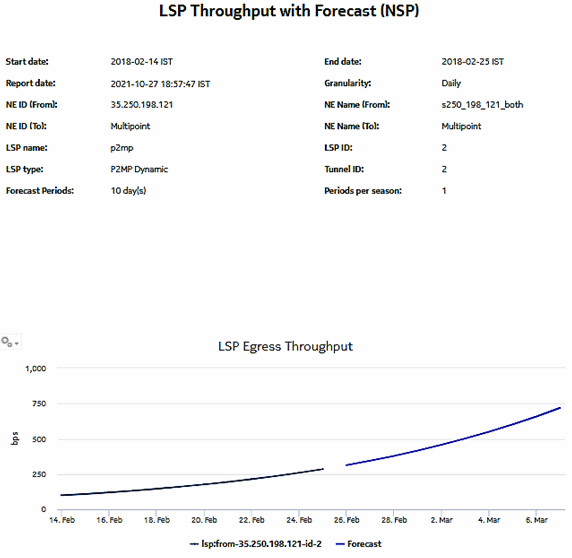LSP Throughput with Forecast (NSP) report
LSP Throughput with Forecast (NSP) report overview
The LSP Throughput with Forecast (NSP) report provides the throughput trend for an LSP. The report can generate a forecast, depending on the granularity; the forecast is generated for daily and monthly granularities. There is no forecast plot for raw and hourly granularities; forecast periods and periods per season are ignored in this case.
Use cases
Capacity planning—Use the report to examine LSP throughput data for planning future capacity requirements.
Limitations
Minimum and maximum throughput aggregation cannot be compared with the minimum and maximum throughput values generated from raw granularity.
Prerequisites
The session time zone must match the aggregation time zone. When these two settings are different, the report does not run correctly and the system returns an error. See section How do I configure the Analytics session time zone? for more information about configuring the session time zone.
To configure LSP records collection, perform “Steps to follow to use IETF framework” from the Network Developer Portal, and create LSPs using postman to post the IETF tunnel creation to the server, as shown in the examples provided in IETF framework in the Network Developer Portal.
NEs must be in IPV4 format. The IPV6 format is currently not supported
The following table describes the aggregation rules that must be enabled and the telemetry subscriptions that must be configured for the NEs on which statistics are to be collected. The aggregation rules must be enabled to view the report for granularities other than raw data; see How do I configure analytics aggregation?. Enable aggregation and configure telemetry subscriptions; see the Telemetry information on the Network Developer Portal and the NSP Data Collection and Analysis Guide.
See the NSP NFM-P Statistics Management Guide for information about creating or modifying a specific MIB statistics policy using a bottom-up method.
Table 19-7: LSP Throughput with Forecast (NSP) report prerequisites
|
Aggregator name |
Monitored object class |
Statistics class |
Statistics collection |
NE types |
|---|---|---|---|---|
|
md-aggr:/md-aggr-base/telemetry-base-lsps-lsp-egress/telemetry-base-lsps-lsp-egress |
lsp |
telemetry:/base/lsps/lsp/egress |
Telemetry statistics |
7750 MD SR Classic NE with gRPC telemetry collection enabled |
|
md-aggr:/md-aggr-base/telemetry-base-lsps-lsp-egress-path/ telemetry-base-lsps-lsp-egress-path |
lsp path |
telemetry:/base/lsps/lsp/ egress/path |
Telemetry statistics |
7750 MD SR Classic NE with gRPC telemetry collection enabled |
The following table describes the LSP Throughput with Forecast (NSP) report prerequisites for NFM-P-managed NEs.
Table 19-8: LSP Throughput with Forecast (NSP) report prerequisites for NFM-P-managed NEs
|
Aggregator name |
Monitored object class |
Statistics class |
Statistics collection |
MIB |
NE types |
|---|---|---|---|---|---|
|
MPLS LSP Egress Aggregator |
mpls.DynamicLsp mpls.P2MPDynamicLsp mpls.SegmentRoutingTeLsp |
mpls.mplsLspEgress |
Performance statistics |
TIMETRA- MPLS- MIB.vRtr MplsLsp Statistics Entry |
7750 SAR 7750 SR Note: 7210 SAS and 7250 IXR are not supported |
Report characteristics
The following table lists the principal report characteristics.

